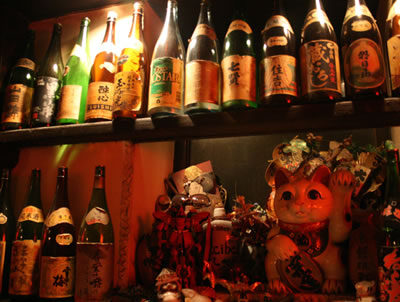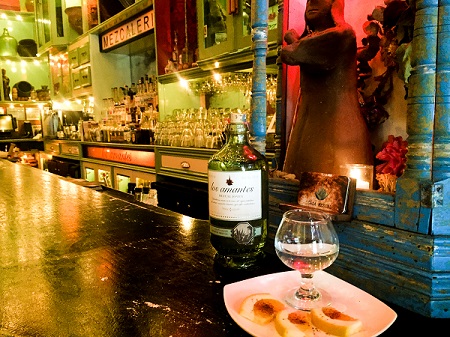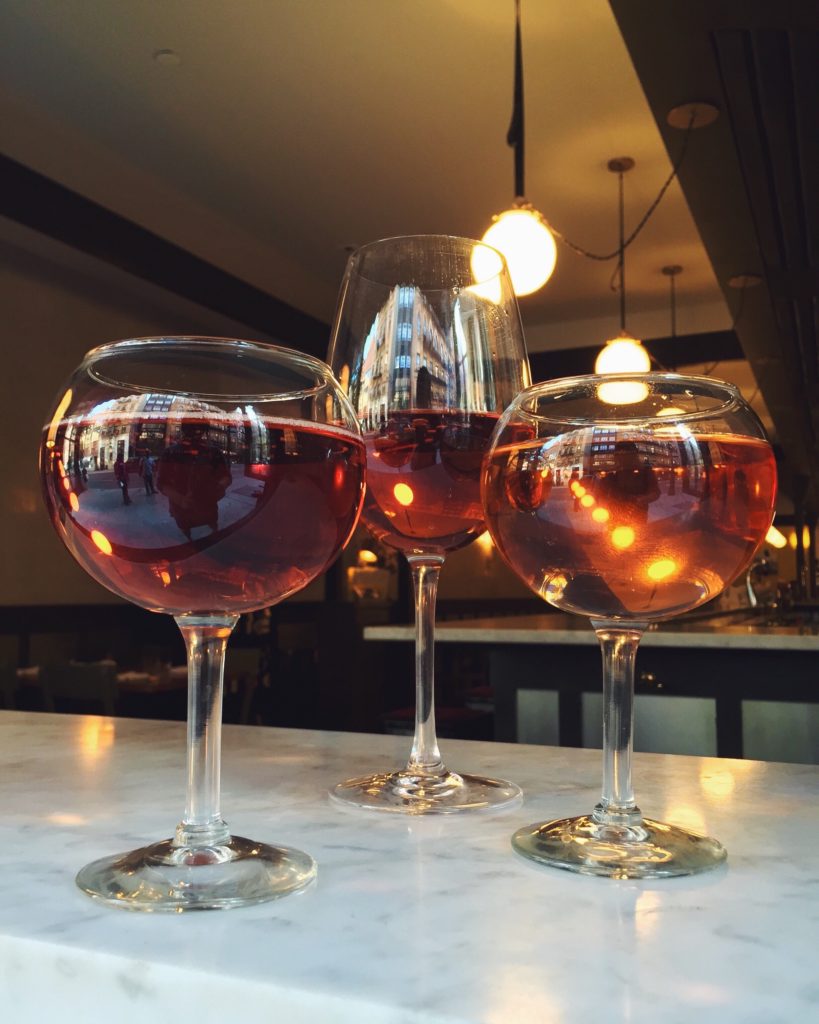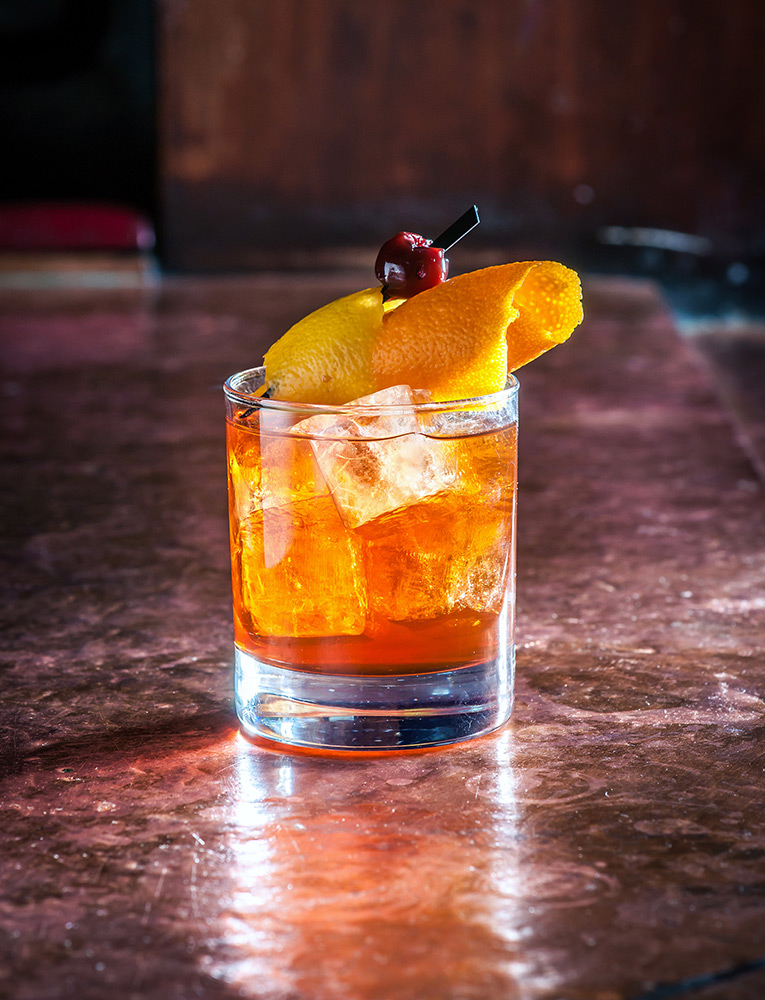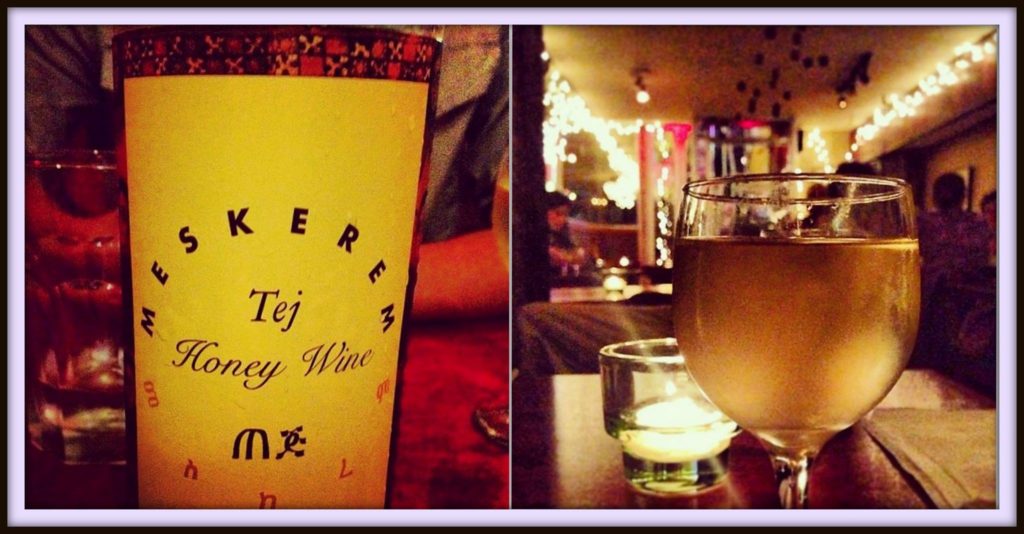While the most common servings at NYC bars comes in the form of beer, wine, and whiskey, we’re here to widen your horizons of heady intoxicants. Let’s travel through Manhattan to some NYC restaurants and bars to let you taste everyone else’s version of infatuation with fermentation.
Kanpai! Japan’s Shots of Sake at Sake Bar Decibel
Sake is one of the fun boozy beverages of choice available in Japan. Contrary to popular belief that terms sake as “rice wine,” in reality, it’s its own category. Whereas wine’s source of intoxication comes from the fermentation of fruits (specifically grapes), sake is derived from rice. In Japan, the usual place to kickback and enjoy good sake is an izakaya, or a Japanese gastropub or tavern. Look no further here, as Sake Bar Decibel puts in great effort to authenticate that feeling in NYC.
Photo: Juan Yen-Chi
Although the basement entrance may look like sketchy New York City from the 1990s, we encourage you to reconsider turning around and leaving. As you head into the cozy and intimate dive, you’ll be impressed to find that their menu makes up for it with over 50 choices of sake. Even as a newcomer to the world of sake, their menu makes it easy to choose from. The menu gives the main ingredient and the flavor profile. You can come hungry as their menu offers small tapas dishes like edamame, dumplings and noodles. Check out here to learn how to give a hearty “kanpai,” or Japanese for roughly “dry the glass,” to finish off your sake the Japanese way!
Mexico’s Mayhem in the Form of Liquid Gold: Mezcal at Casa Mezcal
While tequila has become quite the hit in America, in comparison to its close cousin, mezcal, we’re here to enlighten you with why your mind should be opened to its lesser known relative. Tequila is a specific alcohol derived from Blue Weber Agave and comes from Tequila, Mexico. It’s cousin, mezcal, is made from any species of agave (wild grown variations and tame, controlled variations) and, often times, is made in Oaxaca, although not restricted to just this region (which is also famous for the cheese). While tequila is mass manufactured, mezcal is more of an artisanal craft, often made with techniques that were passed down from generation to generation on small farms in Mexico.
Photo Credit: Martín Capella
With almost 25 varieties of agave that can be made into mezcal, it can be a mesmerizing drink. There are dynamic flavors that give mezcal a unique complexity from one brand to another. To embrace the magical multitude of dimension in mezcal, we recommend one of NYC’s mezcaleria called Casa Mezcal. At Casa Mezcal, you can pair a shot of mezcal with some of their hearty tacos. For those who are new to mezcal, you can dabble in it with one of their various margaritas (some even give an herbal infusion with rosemary or oregano) or a delicious cocktail. They have an upstairs level where you can catch their weekend brunch to pair with your drinks.
Spice Up Your Life with North American Cider at Wassail
The birth of spiked ciders came from the need to satiate the thirst for a boozy beverage to sanitize the system during the not-so-hygienic days of the 1700s. Transporting beer was quite a challenge. Growing barley and yeast on the first grounds that the English settlers landed in America was also not so easy. The solution was to call for apple seeds to be sent from England so they can grow apples to produce hard cider. We also have Johnny Appleseed to thank for helping to spread these orchards during his vagabond journeys. Over time, cider became less popular due to later German and other European immigrants preference for beer. However, many today still have quite the adoration for this boozy treat, like the restaurant Wassail.
Photo Credit: Wassail
In commemoration to the old English cheer, “waes hael,” this means “good health” or “be well.” This restaurant solely revolves their menu around their love for cider. Their drink menu includes over 90 ciders from the tap and by bottle. The drinks origins span all over America, as well as a few choices from Europe. They even offer tasty bar food to enjoy with your sips of cider, including croquettes and potato skins. For larger appetites, you can enjoy the amazing meals that they offer from their seasonal menus. The menus pair well with their ciders, which bring their culinary inspirations from different regions where cider is made.
Run toward the Rum, the Flavors of the Caribbean at Rum House
Rum was the answer to a sticky situation that sugar planters had. They were left with the unwanted molasses that came from boiling sugarcane juice to get the crystallized sugar. One farmer brilliantly decided to ferment the unwanted sugar liquid (as the answer to many things in life is to ferment it) and thus the birth of rum. If you want to enjoy this in true sophisticated ambiance, Rum House is a trip down memory lane of the days of old-time jazz bars with an impressive menu of rums. Their menu includes over 50 premium, spiced, and aged rums from all over the Caribbean. Enjoy some of the best rum on the rocks or in one of their delicious cocktails, such as the Dark & Stormy.
Photo Credit: Rum House
Sweet, Sweet Ethiopian Tej at Meskerem Ethiopian Restaurant
After 2,000 years old on the dinner table in many Ethiopian homes, tej is sweeping through NYC. Often known as the national drink of Ethiopia, this sweet fermented concoction is made of honey, water and gusho (a buckthorn plant native to Ethiopia). Essentially, it is honey wine. Tej, like the wines we are most familiar with, comes in different flavor profiles. Derek is a drier wine that has been fermented longer and makakalanya is perfect for those who want a medium sweetness (it is most frequently consumed). Laslasa is the sweetest.
Photo Credit: Meskerem Ethiopian Cuisine
For a glass of goodness, head to Meskerem Ethiopian Cuisine, where they offer their own tej. We recommend dining in to enjoy their Ethiopian cuisine. The meals are filling, tasty, utensil-free, and worth getting out of the comfort zone to try. The recommended dish is their combo because it gives you a little of everything. The combo comes with a slightly sour flatbread called injera, which serves as your edible utensil.
You take the injera, use it like pincers for your food and pop the whole thing in your mouth. We remind you to breath and to take sips of wine in between bites for maximum enjoyment. You won’t regret it.
A Serbian Specialty Called Rakija at Kafana
Rakija is often passed around in good company in Serbia and Croatia. The drink is viewed by the native drinkers the same way Caribbean people treat rum: it’s quite the cure-all. Got a tummy ache? Grab the rakija. Got muscle pain? Grab the rakija. And so on. This powerful little punch of a drink is fermented from really just about anything. This includes trees, herbs, fruits, vegetables and even truffles. The proof ranges from 40-120. The varieties depend on the type of ingredient used in fermenting the rakija. Base ingredients used get their own name and have their own underlying flavors behind the initial hit of potency.
Photo Credit: The Balkan Backpacker
We’ll be honest, this is on our list because it has quite the interesting background. It’s the unicorn to find in the NYC drinking scene. The last sighting for this exotic treat is Kafana Restaurant, which is an Eastern European restaurant known for its delicious Serbian fare. Named after the Serbian word for “coffee house-bar,” it seems like the perfect name since this is a common place to gather and socialize in Eastern Europe. The menu items will leave your tummies filled with savory meals, such as the highly recommended sausages. In the case you don’t catch a glass of rakija, they also offer a long list of Eastern European red, white, and orange wines to satisfy the buzz.
